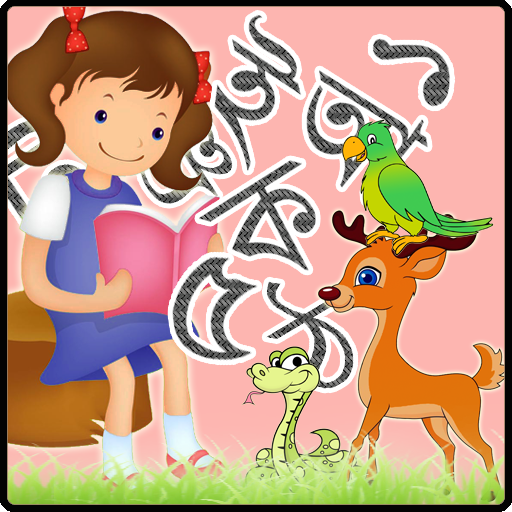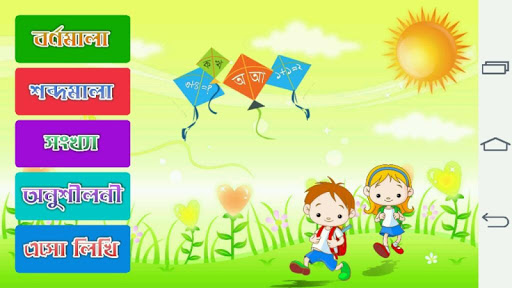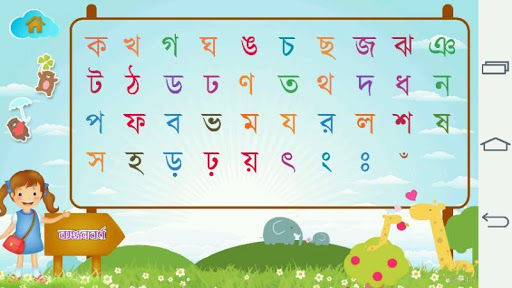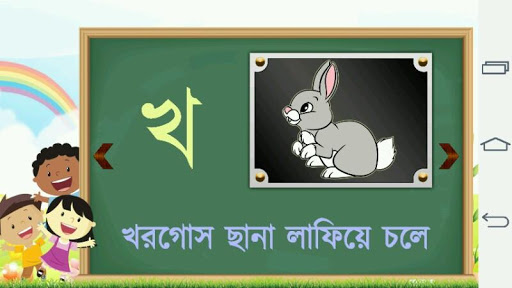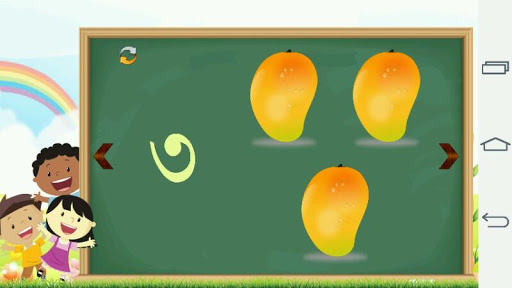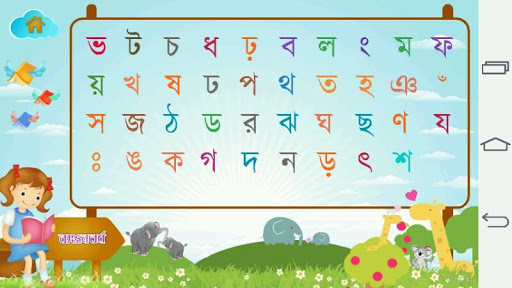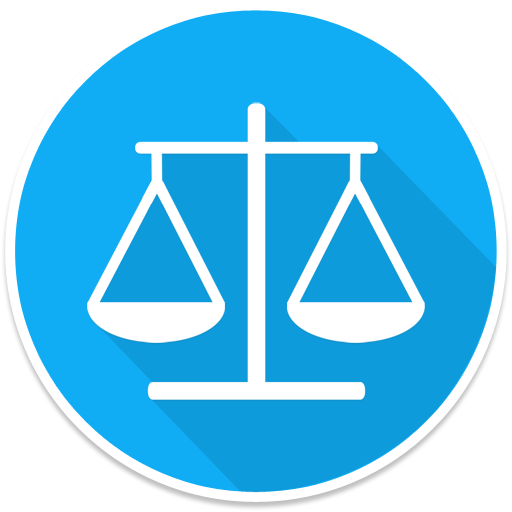Bengali Alphabet for Kids is one of the complete android applications for Bengali alphabet learning. There are few excellent features in this application which will make the kids interested to use this application more and more, and eventually they will learn more. The features are given below,
1. List of all vowel (bengali) characters with pronunciation.
2. List of all consonant(bengali) characters with pronunciation.
3. Numbers (1-10) with example images.
4. Kids can practise hand-writing of characters and numbers, and save it.
5. Each character has nice traditional rhyme (line) with sound. [please see the sample images]
6. Few Exercise:
-> Completely random set of vowel and consonant to test the skill.
-> Multiple choices after counting pictures.
The Bangla alphabet, also known as the Bengali script, is an abugida writing system used to write Bengali, Assamese, and several other languages of South Asia. It is one of the major writing systems of the Indian subcontinent, along with the Devanagari and Perso-Arabic scripts.
The Bangla alphabet consists of 51 letters, including 11 vowels and 40 consonants. The vowels are represented by independent letters, while the consonants are represented by consonant-vowel conjuncts. The script is written from left to right, with a horizontal line connecting the letters within a word.
The Bangla alphabet is a relatively young script, having developed from the Siddham script around the 10th century CE. It was influenced by the Devanagari script, which is used to write Sanskrit, and by the Perso-Arabic script, which is used to write Urdu and Persian.
The Bangla alphabet is used to write a wide variety of texts, including literary works, religious texts, and scientific texts. It is also used in the media, in education, and in government.
History
The Bangla alphabet evolved from the Siddham script, which was used to write Sanskrit in India. The Siddham script was introduced to Bengal in the 7th century CE, and it gradually evolved into the Bangla alphabet over the next few centuries.
The earliest known inscription in the Bangla alphabet dates back to the 10th century CE. This inscription was found on a copper plate in the Dinajpur district of Bangladesh. The inscription records a land grant made by the Pala king Dharmapala.
The Bangla alphabet continued to evolve over the centuries, and it reached its present form in the 18th century CE. The modern Bangla alphabet was standardized by the Bangla Academy in 1956.
Structure
The Bangla alphabet consists of 51 letters, including 11 vowels and 40 consonants. The vowels are represented by independent letters, while the consonants are represented by consonant-vowel conjuncts.
The vowels are:
* অ (a)
* আ (aa)
* ই (i)
* ঈ (ii)
* উ (u)
* ঊ (uu)
* ঋ (ri)
* ৠ (rii)
* ঌ (e)
* ঐ (oi)
* ঔ (ou)
The consonants are:
* ক (ka)
* খ (kha)
* গ (ga)
* ঘ (gha)
* ঙ (nga)
* চ (cha)
* ছ (cha)
* জ (ja)
* ঝ (jha)
* ঞ (nya)
* ট (ta)
* ঠ (tha)
* ড (da)
* ঢ (dha)
* ণ (na)
* ত (ta)
* থ (tha)
* দ (da)
* ধ (dha)
* ন (na)
* প (pa)
* ফ (pha)
* ব (ba)
* ভ (bha)
* ম (ma)
* য (ya)
* র (ra)
* ল (la)
* শ (sha)
* ষ (sha)
* স (sa)
* হ (ha)
* ড় (rra)
* ঢ় (ddha)
* য় (ya)
* ৱ (wa)
The Bangla alphabet is written from left to right, with a horizontal line connecting the letters within a word. The script is cursive, and the letters are often connected to each other in a flowing manner.
Usage
The Bangla alphabet is used to write a wide variety of texts, including literary works, religious texts, and scientific texts. It is also used in the media, in education, and in government.
The Bangla alphabet is the official script of Bangladesh and the Indian state of West Bengal. It is also used in the Indian states of Tripura, Assam, and Jharkhand.
Conclusion
The Bangla alphabet is a rich and complex writing system that has been used for centuries to write a wide variety of texts. It is an important part of the cultural heritage of Bangladesh and West Bengal, and it continues to be used by millions of people around the world.
Bengali Alphabet for Kids is one of the complete android applications for Bengali alphabet learning. There are few excellent features in this application which will make the kids interested to use this application more and more, and eventually they will learn more. The features are given below,
1. List of all vowel (bengali) characters with pronunciation.
2. List of all consonant(bengali) characters with pronunciation.
3. Numbers (1-10) with example images.
4. Kids can practise hand-writing of characters and numbers, and save it.
5. Each character has nice traditional rhyme (line) with sound. [please see the sample images]
6. Few Exercise:
-> Completely random set of vowel and consonant to test the skill.
-> Multiple choices after counting pictures.
The Bangla alphabet, also known as the Bengali script, is an abugida writing system used to write Bengali, Assamese, and several other languages of South Asia. It is one of the major writing systems of the Indian subcontinent, along with the Devanagari and Perso-Arabic scripts.
The Bangla alphabet consists of 51 letters, including 11 vowels and 40 consonants. The vowels are represented by independent letters, while the consonants are represented by consonant-vowel conjuncts. The script is written from left to right, with a horizontal line connecting the letters within a word.
The Bangla alphabet is a relatively young script, having developed from the Siddham script around the 10th century CE. It was influenced by the Devanagari script, which is used to write Sanskrit, and by the Perso-Arabic script, which is used to write Urdu and Persian.
The Bangla alphabet is used to write a wide variety of texts, including literary works, religious texts, and scientific texts. It is also used in the media, in education, and in government.
History
The Bangla alphabet evolved from the Siddham script, which was used to write Sanskrit in India. The Siddham script was introduced to Bengal in the 7th century CE, and it gradually evolved into the Bangla alphabet over the next few centuries.
The earliest known inscription in the Bangla alphabet dates back to the 10th century CE. This inscription was found on a copper plate in the Dinajpur district of Bangladesh. The inscription records a land grant made by the Pala king Dharmapala.
The Bangla alphabet continued to evolve over the centuries, and it reached its present form in the 18th century CE. The modern Bangla alphabet was standardized by the Bangla Academy in 1956.
Structure
The Bangla alphabet consists of 51 letters, including 11 vowels and 40 consonants. The vowels are represented by independent letters, while the consonants are represented by consonant-vowel conjuncts.
The vowels are:
* অ (a)
* আ (aa)
* ই (i)
* ঈ (ii)
* উ (u)
* ঊ (uu)
* ঋ (ri)
* ৠ (rii)
* ঌ (e)
* ঐ (oi)
* ঔ (ou)
The consonants are:
* ক (ka)
* খ (kha)
* গ (ga)
* ঘ (gha)
* ঙ (nga)
* চ (cha)
* ছ (cha)
* জ (ja)
* ঝ (jha)
* ঞ (nya)
* ট (ta)
* ঠ (tha)
* ড (da)
* ঢ (dha)
* ণ (na)
* ত (ta)
* থ (tha)
* দ (da)
* ধ (dha)
* ন (na)
* প (pa)
* ফ (pha)
* ব (ba)
* ভ (bha)
* ম (ma)
* য (ya)
* র (ra)
* ল (la)
* শ (sha)
* ষ (sha)
* স (sa)
* হ (ha)
* ড় (rra)
* ঢ় (ddha)
* য় (ya)
* ৱ (wa)
The Bangla alphabet is written from left to right, with a horizontal line connecting the letters within a word. The script is cursive, and the letters are often connected to each other in a flowing manner.
Usage
The Bangla alphabet is used to write a wide variety of texts, including literary works, religious texts, and scientific texts. It is also used in the media, in education, and in government.
The Bangla alphabet is the official script of Bangladesh and the Indian state of West Bengal. It is also used in the Indian states of Tripura, Assam, and Jharkhand.
Conclusion
The Bangla alphabet is a rich and complex writing system that has been used for centuries to write a wide variety of texts. It is an important part of the cultural heritage of Bangladesh and West Bengal, and it continues to be used by millions of people around the world.

